BASE HEADER
Royal Leamington Spa Neighbourhood Development Plan
3.0 Spatial Portrait
ROYAL LEAMINGTON SPA KEY FACTS
First mentioned in the Domesday Book of 1086 as Lamintone The old village of Leamington Priors was on the southern bank of the River Leam. In 1814, the Royal Pump Rooms and Baths were opened close to the River Leam. Following the granting of a 'Royal' prefix in 1838 by Queen Victoria, 'Leamington Priors' was renamed 'Royal Leamington Spa'.
Population: 49,491
Area: 1,318 hectares (3,257 acres)
Dwellings: 21,906
Under 4s: 2,826 (5.7% of population)
Under 18s: 8,673 (17.5%)
18-29s: 12,623 (25.5%)
30-59s: 23,226 (46.9%)
Over 60s: 9,398 (19%)
White: 86%
Asian/Asian British: 9.2%
Indian: 6.4%
(all figures 2011 Census)
National Heritage List for England: 444 entries, mostly Listed Buildings.
4 Conservation Areas
People
3.1 Royal Leamington Spa is probably, by population size, the largest neighbourhood plan prepared so far. There were 49,491 usual residents within the town at Census day 2011. Of these, 98.1% lived in households and 1.9% lived in communal establishments. The average (mean) age of residents was 37.4 years.
3.2 Royal Leamington Spa has fewer young people in the school age groups when compared with Warwick District and England (Figure 3) but more young people in the 20-24 age group, this reflects the large student population living in the area. Royal Leamington Spa also has higher proportion of people in the 25-29 and 30-44 age groups, but lower proportions of those in older age groups. However, older residents, those aged over 65, still form a significant section of the population (13.1%) or 6,948 residents. A key objective of the neighbourhood plan is to meet the varying needs of all age groups and sections of the local community.
3.3 Figure 4 shows the ethnic group of Royal Leamington Spa residents. The local population is 86% White, compared with 89.2% in Warwick District, 85.4% England. In Royal Leamington Spa 9.2% of the population are Asian/Asian British compared with 7.2% Warwick District, 7.8% England. 6.4% of Royal Leamington Spa residents are in the Indian ethnic group.
Figure 3. 2011 Census Population by Age Group, Royal Leamington Spa, Warwick District and England (Source: Nomis)
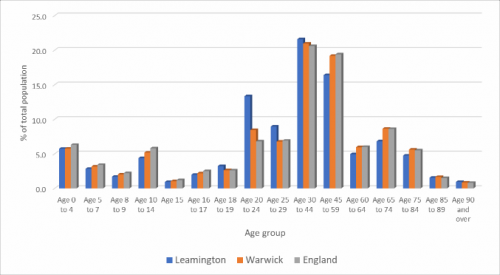
Figure 4. 2011 Census Population by Ethnic Group, Royal Leamington Spa (Source: Nomis)
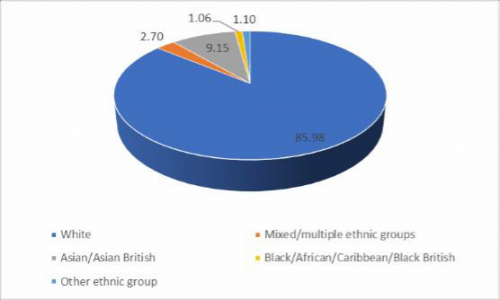
3.4 Royal Leamington Spa residents, possibly reflecting the younger age profile of the area, generally describe themselves as enjoying better health than comparable figures for Warwick District, but not those for England (Table 2). Almost 7%, or 3,420 residents consider their health limits their day-to-day activities.
Table 2. Health (Source: Nomis)
|
Royal Leamington Spa |
Warwick District |
England |
|
|
Residents who consider their Day-to-day activities are limited alot (%) |
6.9 |
8.3 |
6.4 |
|
Residents who consider they have "bad" or"very bad" health(%) |
4.5 |
5.4 |
4.0 |
3.5 There were 21,906 dwellings in Royal Leamington Spa at the time of the 2011 Census. The breakdown of dwelling types is very different from that in the District and in England. This reflects the historic development of Royal Leamington Spa, particularly as a Spa town (Table 3)
3.6 Again, probably reflecting the area's large student population and younger workforce the tenure split in Royal Leamington Spa is very different from that in the District as a whole, and for England, with a greater proportion of private rented properties: 25.6% of all dwellings, compared with 16.8% for the District and 17.9% for England. There is also a greater proportion of housing for social rent in Royal Leamington Spa: 18.6% compared with 17.7% in the District and 13.4% in England. As a result, the proportion of privately- owned housing is much less: 54% in Royal Leamington Spa; 63.3% in Warwick District and 66.7% in England. Student households make up 4.6% of all households, the figure for the District being only 0.6% of households.
Table 3. Dwellings, Percentage by Dwelling Type (Source: Nomis)
|
Dwelling Type |
Royal Leamington Spa |
Warwick |
England |
|
Whole house or bungalow: Detached |
12.2 |
22.3 |
24.3 |
|
Whole house or bungalow: Semi-detached |
27.9 |
30.7 |
30.9 |
|
Whole house or bungalow: Terraced (including end-terrace) |
23.7 |
24.5 |
21.5 |
|
Flat, maisonette or apartment: Purpose-built block of flats or tenement |
24.6 |
16.7 |
17.2 |
|
Flat, maisonette or apartment: Part of a converted or shared house (includingbed-sits) |
9.8 |
4.3 |
4.6 |
|
Flat, maisonette or apartment: In a commercial building |
1.7 |
1.1 |
1.3 |
3.7 One of the key issues that has been identified for the RLSNDP has been the need to reduce the impact of private cars and to encourage other forms of transport. This is especially important, given that the 2011 Census figures, reveal a significant proportion of the population do not have access to a car (26.3%, 5,595 households). This is slightly higher than the District figure (25.8%) and much higher than the national figure (18.5%).
3.8 Once again reflecting the large student population, economic activity in Royal Leamington Spa is slightly below the District and national figure: 68.2%. 69.9% and 71.3% respectively. The corresponding proportion of students is 14.2%; 5.8% and 2.9%. The percentage of retired residents in Royal Leamington Spa is less (10%) than Warwick District (13.7%) and England (12.9%).
3.9 Perhaps, unsurprisingly, given what has already been said about Royal Leamington Spa's significant student population, qualification levels of residents are much higher than for the District. Those with Level 4 qualifications, or higher, are 37.1% for Royal Leamington Spa and 27.4% for the District. Those with such qualifications in England are 38.4%. The figures for those with no qualifications are Royal Leamington Spa 16.8%; Warwick 22.5%; England 16.4%.
People
3.10 The neighbourhood area (Map 1) covers some 1,317 hectares and lies to the east of Warwick. The two settlements, almost forming one continuous urban area, are separated by the River Avon.
3.11 Regionally, Royal Leamington Spa lies within the West Midlands, 37 miles south east, 41 minutes from Birmingham by motorway; 11 miles south, 18 minutes from Coventry on the A46. Comparable rail journeys from Royal Leamington Spa railway station are 31 minutes to Birmingham; 16 minutes to Coventry. There are direct rail services to London, Manchester and the North East and South West.
3.12 The historic development of Royal Leamington Spa is dominated by the development of the earlier village of Leamington Priors into a Spa town beginning in the 19th Century. The village taking its name from the River Leam that flows through the centre of the town and, today, separates north from south Royal Leamington Spa.
3.13 The original spring was Aylesford Well, adjacent to All Saints parish church. This occurred naturally, six further wells were drilled, and as the reputation and marketing of the health- giving properties of the local spring water gathered pace so, too, did the rapid development from this original settlement.
3.14 The early development of the town started on the southern bank of the River Leam. During the 1820s and 1830s, Royal Leamington Spa expanded on the land to the north of the river, resulting in the Regency and Georgian New Town, with buildings and parks, such as the Royal Pump Rooms and Baths, Jephson Gardens and the Georgian townhouses built to accommodate the growing number of visitors. The growth of Royal Leamington Spa was rapid; at the time of the first national census in 1801, Royal Leamington Spa had a population of just 315, by 1851 this had grown to 15,724, and by 1901, the population had grown to nearly 27,000.
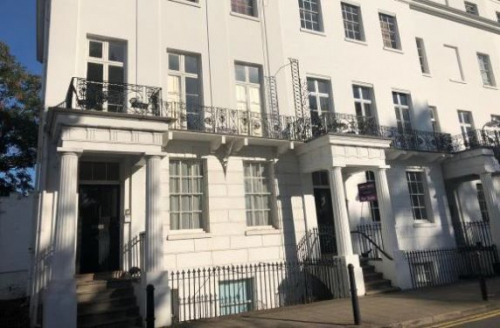
6 Clarendon Square
3.15 When the "Royal" prefix was granted by Queen Victoria in 1838, Leamington Priors was renamed 'Royal Leamington Spa'.
3.16 With the decline in the popularity of the Spa, the economy of Royal Leamington Spa declined towards the end of the 19th century and Royal Leamington Spa became a popular place to live, particularly the middle class from larger centres, such as Coventry and Birmingham.
3.17 In the 19th and 20th Centuries Royal Leamington Spa's economy became more diverse and manufacturing grew in parts of the town, taking advantage of the railway and canal. A major boost to the local economy was the re-location of car manufacturing from Coventry after World War II. Manufacturing remains an important part of the town's economy, providing about 10% of local employment, from locations such as the Sydenham Industrial Estate, and making an important contribution to the West Midlands automotive industry.
3.18 The town centre with its unique and high-quality environment provides a sub-regional focal point for retail, leisure and other employment. The centre was relatively resilient to the recession in the early 2010s and competition from online retailing and other retail destinations and town centres in the sub-region. However with closure of anchor stores, such as BHS, this threat remains. Leamington Shopping Park which lies on the periphery of the town and outside parish boundary and Neighbourhood Plan Area.
3.19 The areas around central and south Royal Leamington Spa have become popular for students, particularly from the University of Warwick. The town centre provides a good range of facilities for young people and a thriving evening economy. In addition, the housing stock, much of it a legacy of the Spa town, lends itself to the provision of shared houses and flats. This has led to problems for existing, long-term residents and an Article 4 direction is in place to manage conversion to houses in multiple occupation.
3.20 Royal Leamington Spa will continue to be affected by the strategic urban expansion to the south of Warwick and Royal Leamington Spa. This will deliver an estimated 4,345 dwellings. This whole area has been granted planning permission and parts are now under construction. In addition to housing, the area will deliver new secondary school facilities, four primary schools, local GP services, shops, community facilities and an important buffer of open space to the south to be delivered as Tachbrook Country Park.
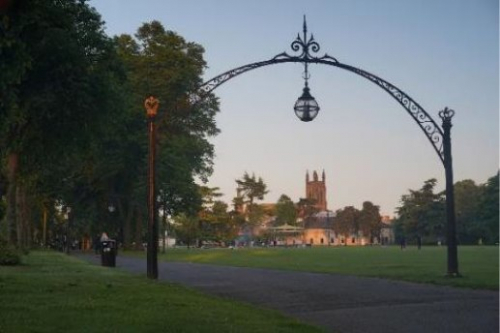
7 View of Parish Church and Pump Rooms (Richard Cunningham)
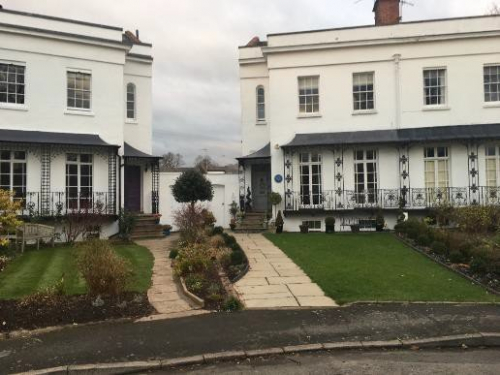
8 Houses on Lansdowne Circus